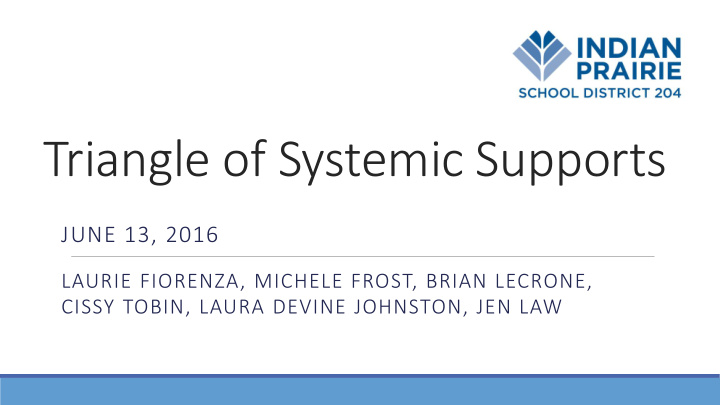



Triangle of Systemic Supports JUNE 13, 2016 LAURIE FIORENZA, MICHELE FROST, BRIAN LECRONE, CISSY TOBIN, LAURA DEVINE JOHNSTON, JEN LAW
Current status • Schools have been using the RtI process for many years. • Individual problem solving (Tier 3) process is well established. • District had invested time, training and resources into several interventions prior to implementation of the new Illinois Learning Standards. • Needed to update that work to align tiered systems of support, assessment and PLC’s.
Goals • To develop a common list of interventions that can be supported by the district. • To ensure that schools are using valid interventions by creating a list of tools that will be supported by the district. • To capitalize on the knowledge and experience from other buildings in our district. • To utilize the principals and district office administrators to implement the PLC process. • To create a system to vet future interventions and evaluate intervention effectiveness.
Connecting Response to Intervention and Professional Learning Communities PLC Q1: What do we want students to Tier 3 learn? (ELA/Math/SEL) PLC Q2: How will we know if they Tier 2 learned it? (ELA/Math/SEL) PLC Q3: What will we do if students Tier 1 don’t learn it? Instructional Strategies PLC Q4: What will we do if they already know it? PLC #1 Curriculum & Standards Based upon the work of Richard DuFour
Descriptors of Research Validation http://iris.peabody.vanderbilt.edu/module/ebp_01
Principal and District Administration Group Process 1. Learned about the RtI and Pyramid of Interventions process together and developed common definitions. 2. Conducted an audit of interventions being used across the district in four areas: ELA (English Language Arts), Math, Social Emotional Learning, & Instructional Strategies. Instructional tech department conducted an audit simultaneously. 3. Worked in small groups to review and to begin vetting most prevalent interventions. 4. Shared vetting process with instructional specialists in C&I 5. Discussed criteria for district support for an intervention 6. Established steps for next year
Index Resource for schools to use when looking for an intervention.
Vetting Process 1. Established a protocol for vetting interventions 2. Started with interventions used most prevalently across district 3. Reviewed publisher’s information 4. Reviewed independent peer reviewed research 5. Used common references such as whatworks.gov and CASEL
Criteria for District Support 1. Develop the district Triangle of Systemic Supports to ensure that there is an intervention at each tier for each subject area. Use stakeholder groups to make recommendations. 2. Look at factors such as training, sustainability, adaptability, effectiveness and cost Training- What training is required? How is it offered? Is there an ongoing training cycle? Can we offer it locally? What is the cost? Effectiveness- Is there local or national data to support this intervention? (work with assessment group to determine methods of data collection) Adaptability- addressing building needs, looking at guidelines for implementation- size of group, who can implement, etc Sustainability- Can the school sustain the intervention- is it person dependent? Is it cost effective?
Example of District Triangle SuperFlex, Equals, Zones of Wilson AVMR Regulation Guided Math, PATHS, Read Moby Max CICO Naturally ELA curriculum Math curriculum PBIS & CHAMPS Instructional Strategies: Kagan, CRISS Curriculum & Standards
Next Steps 1. Draft district triangle of systemic supports for each area 2. Plan for local assessments (collecting data) on previously used intervention - Use other stakeholders - Link to Assessment Group 3. End of year goal for school triangle - Draft at school - Revisions with Instructional Leadership Teams 4. Refine the process to review a new interventions
Questions
Recommend
More recommend